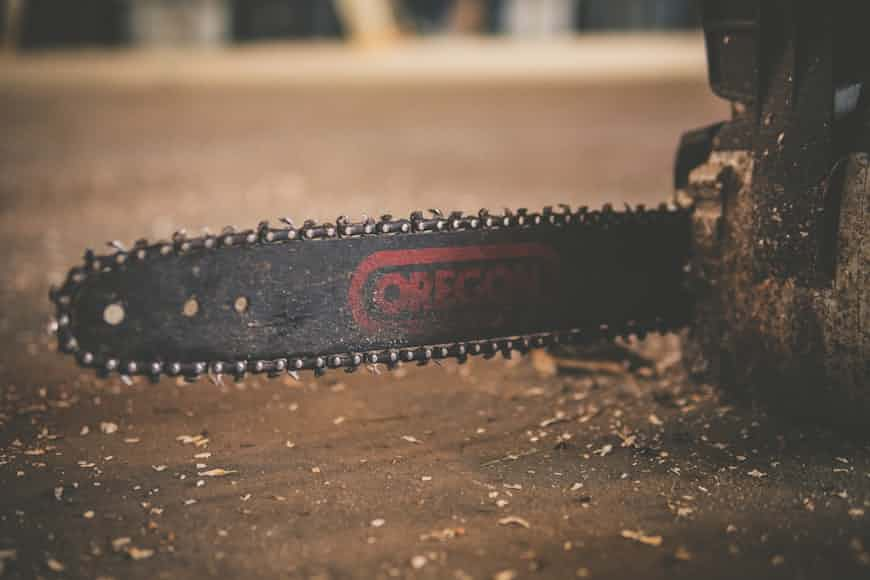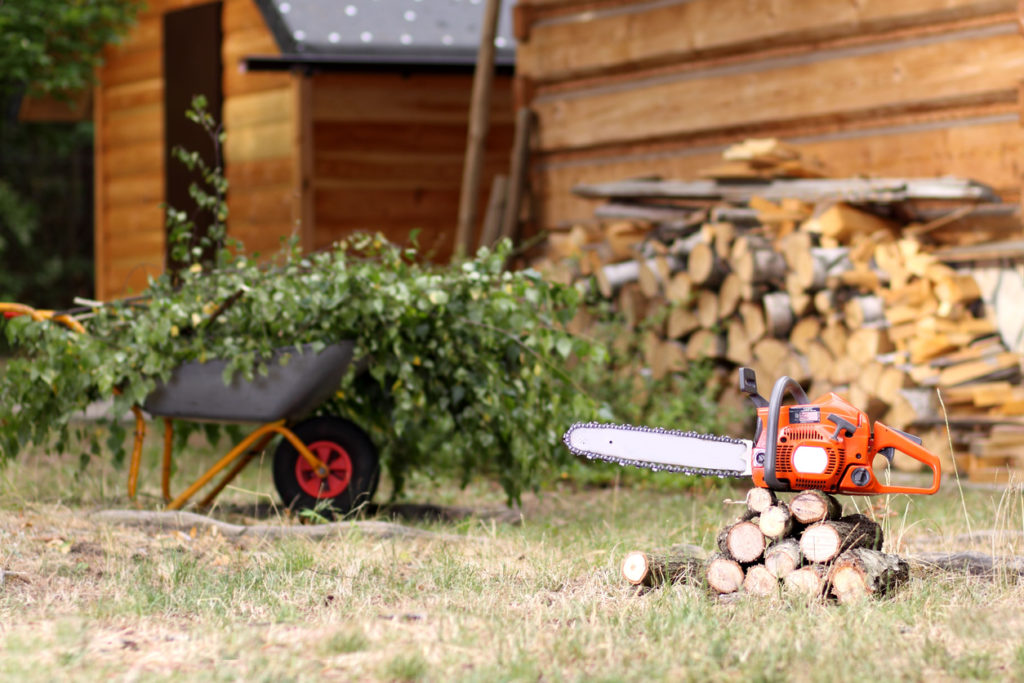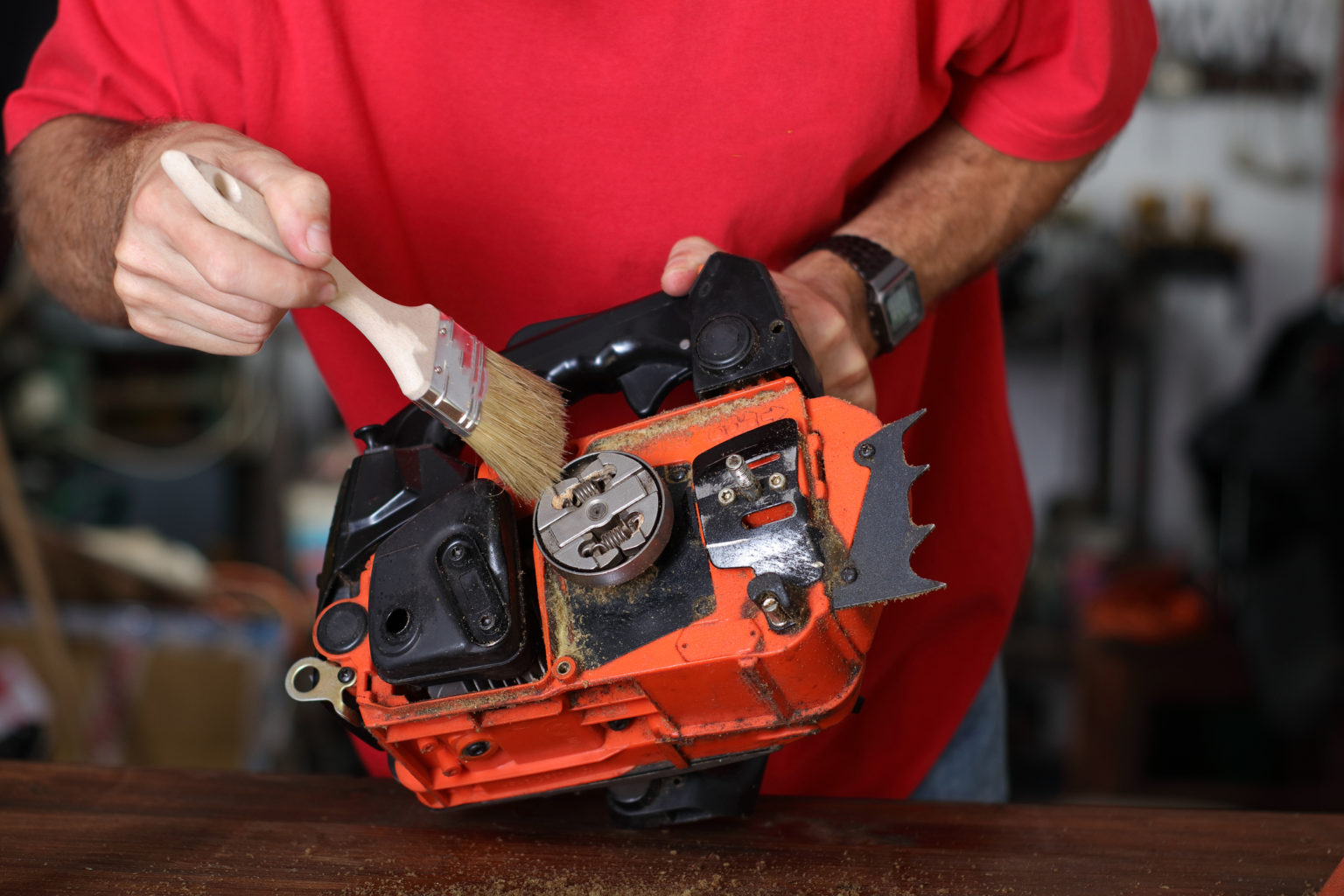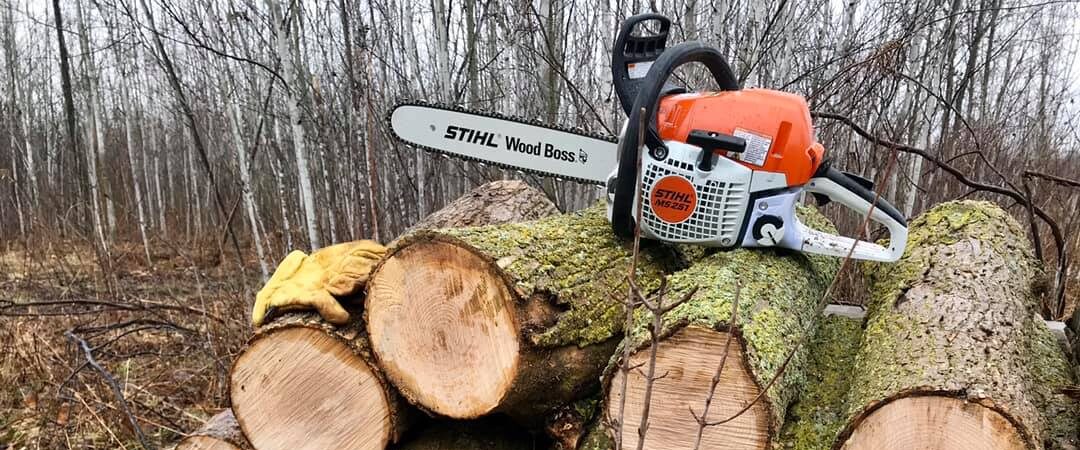Rust is one of the biggest enemies that can interfere with how the chainsaw operates. This corrosion can weaken the metal parts in many ways and ultimately cause the machine to break down. If you want to prevent and eliminate rust, you’ll need to learn how to clean a chainsaw as well as perform some basic maintenance and repairs.
Why Is Rust Bad for Your Chainsaw?
Rust is a form of corrosion that can make metal rough and discolored. It essentially changes the shape of metal surfaces. When rust attacks a chainsaw blade, the once-sharp metal teeth turn blunt and ineffective. This could actually make the chainsaw dangerous to operate.
To keep your chainsaw from developing rust, there are several precautionary measures that you can take. It helps to use the machine regularly. If you only use your chainsaw occasionally, it must be properly stored; otherwise, rust will form easily. Regardless of its frequency of use, making sure your chainsaw doesn’t get wet — or at least doesn’t stay wet — is essential. Lastly, ensuring that your chainsaw is regularly and adequately lubricated is vital for preventing rust. With basic knowledge of how to store and clean your chainsaw, you can increase the machine’s longevity.

How To Repair Chainsaw Rust (and Maintain Your Equipment!)
Chainsaw parts such as the teeth, engine, and bar will rust easily if the tool is left unmaintained, even with regular use. While you’re removing rust from your saw, it’s a good idea to go through and clean it as well to keep everything in tip-top shape. The first thing you should do is find a work surface that’s sturdy and lets you keep track of your chainsaw’s parts.
Once you’ve found a suitable workspace, it’s time to get started. Chainsaw rust repair isn’t as daunting as it might sound, but we’ve broken it down into some easy-to-follow steps.
Step 1: Gather Your Materials
Other than your chainsaw, you’ll need a few supplies to get rid of rust. They might vary depending on the rust removal method, but in general, you’ll want access to water for rinsing, something to scrub off the rust (like steel wool, a brush, or scouring pads), and towels for drying.
- Ideal for uncoated cookware
- Great for pots, pans, grills, broilers and more
- Long-lasting & Durable
- Cuts through and removes tough soil & burnt-on food FAST!
- Easy to rinse out
Step 2: Depower the Chainsaw
Before beginning the cleaning process, ensure that the chainsaw isn’t connected to power. Remove the batteries if your chainsaw has them. An electric-powered chainsaw needs to be unplugged from its outlet. For a gasoline-powered chainsaw, it is important to apply the chain break and allow the machine to cool off if it was in use.
Step 3: Remove or Disassemble Rusted Parts
To effectively clean rusted parts, it is essential to remove them from the machine. Chainsaw construction might vary from manufacturer to manufacturer, so make sure to consult your chainsaw’s manual to see how to take it apart. You can easily disassemble non-electrical parts such as the bar and the chain for cleaning.
Step 4: Use a Rust Remover on the Rusted Parts
Rusting is a chemical process; to remove the machine’s rust, you’ll need a chemical solution. That doesn’t mean you need to buy specific rust-removing items, though — you probably have some rust removers around your house. Some commonly used removers include:
- White vinegar: Find a spray bottle and fill it with white vinegar; there’s no need to dilute it. Spray the rusted parts with this solution. Let the vinegar stay on the rusted parts for 30 minutes before buffering off the rust. For particularly corroded parts or stubborn rust, you can leave the vinegar on for up to two hours.
- VERSATILE PANTRY STAPLE: Perfect for cooking, pickling, marinating, and enhancing your favorite recipes with a crisp, tangy flavor.
- ALL-NATURAL & PURE: Made from 100% distilled white vinegar, free from artificial additives and preservatives for a clean, fresh taste.
- POWERFUL MULTI-PURPOSE CLEANER: A natural, eco-friendly solution for disinfecting, deodorizing, and tackling tough household messes.
- BULK SIZE FOR MORE VALUE: Large 1-gallon jug is perfect for high-volume cooking, canning, and cleaning needs, offering great savings.
- TRUSTED QUALITY FROM IBERIA: A staple in kitchens for generations, Iberia delivers authentic, high-quality ingredients for cooking and beyond.
- Baking soda: Baking soda isn’t just for cookies and cakes. You probably have seen people use it for household cleaning, but it’s also an effective rust remover. To use it, mix baking soda with water to create a paste, then spread it over the metal. Let it sit for a couple of minutes, then gently buff the rust off.
- Ideal for Baking: Made with fine baking soda particles from Grade 1 baking soda to create fluffier recipes; Elevate your baking and enjoy great results with ARM & HAMMER Baking Soda
- Made in USA: Pure baking soda made in Green River, Wyoming that’s ready for baking; Manufactured with a focus on using locally sourced ingredients, renewable electricity, and water from the Green River Basin
- Pure & Natural: Free of harsh chemicals, gluten free, kosher, and can be used in organic baking; ARM & HAMMER is America’s #1 trusted baking soda brand
- 100+ Uses: Hundreds of other uses around your home including cleaning, health and beauty, deodorizing, crafting, and more; Your go-to, multipurpose solution for cleaning and deodorizing around your home
- The ARM & HAMMER Promise: We take care of the planet and create products you know and trust; ARM & HAMMER Baking Soda is certified carbon neutral* *By measuring our carbon footprint and reducing it to zero through internal reductions and offsets
- Salt and citrus: To use this mixture, you will need to sprinkle salt over the rusted area and ensure it is completely covered. Once this is done, squeeze lemon or lime juice over it, and let it sit for four hours. Scrub the salt and citrus off the metal, and rinse it clean with water.
- Ammonia mixture: This is one of the easiest rust removal aids you can make. To create the mixture, take half a gallon of water and mix it with a half cup of household ammonia. Soak the rusted parts in the solution for 20 to 30 minutes, then remove them and buff them clean. Make sure to wear gloves!
- Multipurpose cleaner for laundry and general household chores like cleaning kitchens, sinks, garbage disposals and trash cans
- Use full strength, wait a few minute and rinse with clear water
- Can be used on cement floors
- Best for cleaning kitchens, sinks, garbage disposals, and trash cans
- Use full strength, wait a few minutes, and rinse with clear water
If you don’t have any of the above supplies at home or you want to rely on something formulated specifically to remove rust, a variety of products are available, including WD40 Rust Remover, IRON OUT Rust Stain Remover Spray Gel, Evapo-Rust Original, and Super Safe Rust Remover.
Step 5: Clean Other Pieces
In most cases, you’re not going to have rust on every single part of your chainsaw. Regardless of your rust removal method, while you’re waiting for it to work its magic, you should focus on cleaning the non-rusted parts to keep your chainsaw in good condition and prevent rust from forming in the future. Here are some parts of your chainsaw that likely need cleaning the most:
Spark Plug
A dirty or rusted spark plug may prevent your machine from starting up or lead to malfunctions. To prevent this, ensure that the spark plug has been cleaned before moving on to other machine parts. You can simply wipe it clean; if it’s rusted or damaged, replace it.
Fuel Tank
When cleaning the fuel tank, all the fuel needs to be drained out into a safe container. Once the fuel has been removed, you can clean the tank and refill it with fresh fuel if you’re going to use it regularly. If you only use your chainsaw occasionally, it’s a good idea to store it with little to no fuel in the tank, as gasoline can evaporate and leave behind a sticky residue.
How to Clean Out a Chainsaw Gas Tank
Bar
The guide bar holds the chain and is one of the vital parts of your chainsaw. To clean the bar, you first need to loosen the chain. To do this, look around the chainsaw and you will see a knob that you can use to loosen up the chain and remove it entirely from the bar. Once the chain has been removed, clear any dirt and debris from the bar; you can then use a cleaner such as WD40 to clear out any residue.
Pro tip: When reassembling the bar, put it back on the opposite side it was facing when you removed it from the machine. This will help the bar attach tightly and increase its lifespan and, consequently, the lifespan of the chainsaw.
Chain
When removing the bar from your chainsaw, take the chain off as well. You’ll need to soak the chain in a cleaning solution, like a mix of water and ammonia, for 30 to 45 minutes, then scrub it thoroughly and dry it. Afterward, lubricate the chain.
Chain Lubrication Hole
The lubrication hole is the hole that allows oil to pass through before reaching the chain. You can use a narrow wire or a pipe cleaner to clean this hole. Afterward, test it to be sure the oil is passing through properly.
- Perfect Choice: Whether you’re new to pipe or have owned one for a while, keeping it clean is absolutely paramount. A dirty pipe or glass can not only affect the quality of your time but can cause irreversible damage to your pipe. Lova Pipe Cleaners were made specifically with this in mind and is why many people use them to ensure that they can relax and have a good time.
- Premium Quality: We only use 100% Premium Cotton with every 6 inch pipe cleaner. We then include a flexible wire inside allowing you to bend it into any shape. This will fit opjects including, pipes, radios, and most things you can think of! A pipe cleaner or chenille stem is a type of brush originally intended for removing moisture and residue from whatever your needs may be. Works great for glass too!
- Arts and Crafts: Are you looking for Pipe Cleaners for Arts and Crafts? These are HARD bristle pipe cleaners, we recommend our soft or our arts and crafts pipe cleaners!
- Exceptional Features: These 6 inch pipe cleaners can be used for an endless list of projects. They can be used for cleaning pipes, glass straws, reusable straws, anything with a narrow gap, clocks, radios, cars, and receivers!
- Money Back Guarantee: Buy with confidence! We are a family-owned, American business. We greatly value you as a customer and your satisfaction is our top priority! If you are not fully satisfied with your purchase, contact us within the first 30 days so we can make it right.
Carburetor
Proper cleaning of the carburetor is important to minimize engine problems. To clean this part, you first need to disassemble the carburetor and soak it for about 30 minutes in the ammonia solution you made when cleaning the chain. Once you are done soaking, thoroughly clean the parts with a brush and rinse them with warm water. The clean parts then need to be dried thoroughly to avoid rusting before reassembly.
Spark Arrestor
As the name suggests, the spark arrestor prevents mechanical sparks from coming out and interrupting your work or causing fires. The spark arrestor can get clogged easily, making regular maintenance particularly important. To clean this part, unscrew the cover, remove the spark arrestor, and clear out all the deposits that may be contained. Tapping the arrestor should work fine, but if you have the time, you can use a brush to clean it before reassembling it.
Step 6: Rinse With Water
Once the mixture has worked its magic on the rusted part and you’ve scrubbed the rust free, it’s time to say goodbye to the rust for good. Parts that are sensitive to water might need to be cleaned gently with a wet cloth, but most parts of your chainsaw can be placed under running water.
Step 7: Drying
Once you have rinsed the cleaned parts, it is essential to dry them. If there’s plenty of sunlight, you can leave them out to air dry, but using a blower, towel, or paper towel is generally going to be faster. Remember that if water is left on the parts, it may contribute to the rusting process.
- 7 Amp motor provides a powerful and efficient blowing performance
- Moves up to 180Mph to 180CFM for fast and easy cleanup of leaves and debris. Uses: Ideal for clearing debris from lawns, driveways, sidewalks, and decks
- Built in cord retention prevents frustrating interruptions during cleanup, Moves up to 18Mph to 18CFM for fast and easy cleanup of leaves and debris
- Lightweight at only 4.4 pounds
- Air speed: Up to 180 mph; Included components: (1) LB700 7 Amp blower, (1) Blow tube. Item does not include a cord
Step 8: Clean the Engine
You will need to use a strong brush to remove dirt from the inaccessible parts of the engine. A blower can then remove the residue, dirt, and debris. A steel brush will be the most effective for cleaning the engine of rust.
- Three different types: The pack includes a brass, nylon and metal brush. Suitable for different surface types, they will address all your cleaning concerns.
- Multiple uses: All our brushes serve different purposes! You can use the stainless steel wire brush for rust removal, while the nylon brush is perfect for delicate household appliances. The brass brush is ideal to clean metal surfaces without scratching them.
- Ergonomic design: The handles of each wire brushes for cleaning are slightly angular for an optimum grip. Made with high-quality plastic, they will last you a long time.
- Portable: 7-inch long, they are easy to pop in your toolbox or handbag! So, whether you are going on a cleaning spree at your office or a friend’s place, our wire brush set can go with you.
- Customer satisfaction: We hope you like our product! Each wire scratch brush is versatile, effective and easy-to-use. However, if you have any concerns, please contact us and we will be happy to assist you.
Step 9: Assemble the Chainsaw and Test It

Once you have cleaned all the rusted parts, you will need to reassemble the chainsaw to how it originally was. Once every part is in place, turn on the machine and see if it is working. If the rust was effectively removed, your chainsaw should be operating fine and more efficiently than it was before.
Final Take
Removing rust from a chainsaw requires a lot of time, energy, and effort, but it’s less complicated than you might think. More importantly, completing this process can give you a tool that works better than before and is safer to boot.









